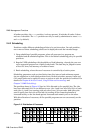
RMS Management Functions
detail in Chapter 6 (Access Control, Usage Limits and Accounting).
Each partition, except the root partition, is managed by a Partition Manager (see
Section 4.4), which mediates user requests, checking access permissions and usage
limits before scheduling CPUs and starting user jobs.
An accounting record is created as CPUs are allocated to each request. It is updated
periodically until the resources are freed. The accounting record itemizes CPU and
memory usage, indexed by job, by user and by project.
2.4.4 RMS Configuration
The set of partitions active at any time is known as a configuration. A system will
normally have a number of configurations, each appropriate to a particular operating
pattern. For example, there may be one configuration for normal working hours and
another for night time and weekend operation.
The CPUs allocated to a partition may vary between configurations. For example, a login
partition (nodes allocated for interactive use) may have more nodes allocated during
working hours than at night – it may even be absent from the night time configuration.
A pair of configurations are shown in Figure 2.7.
Figure 2.7: Two Configurations
Login Development
Parallel
Parallel
Night
Day
16nodes,4CPUspernode
RMS supports automated reconfiguration at shift changes as well as dynamic
reconfiguration in response to a request from an operator or administrator. The RMS
client rcontrol (Page 5-20) manages the switch-over from one configuration to another.
For automatic reconfiguration, rcontrol can be invoked from a cron job.
2-10 Overview of RMS


















